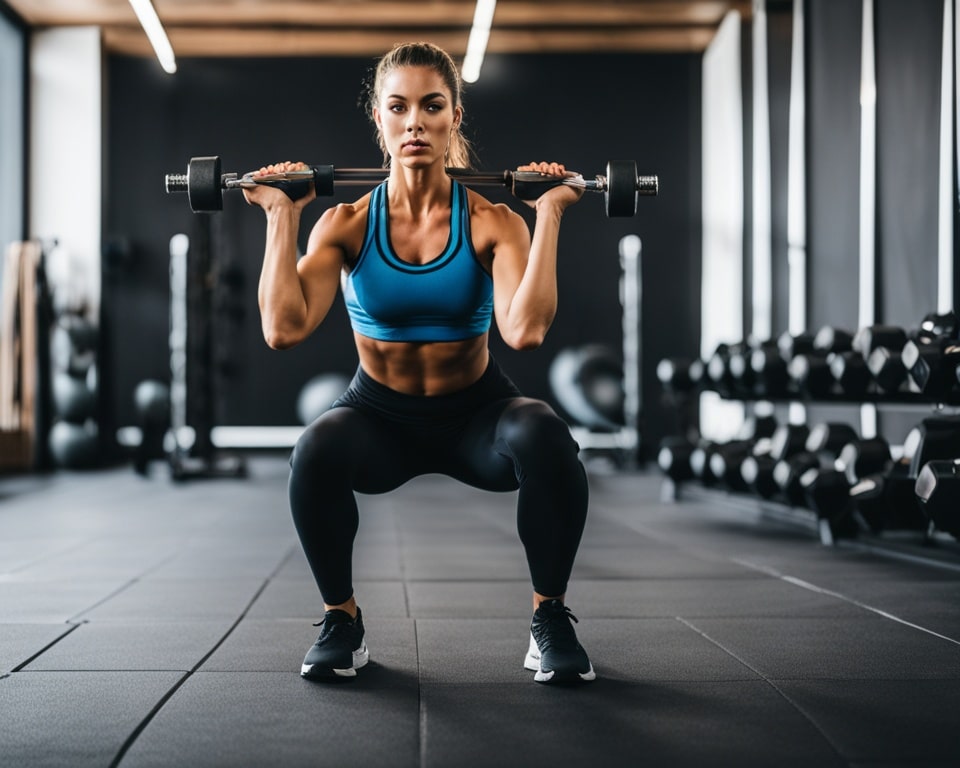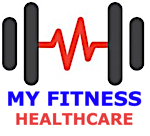Here’s a startling fact: only a few adults exercise 150 minutes a week as recommended. Our lives are mostly sedentary now, making starting a workout routine crucial for our health. I’m here to share simple ways to get active, build muscle, and make exercising a regular part of your life.
Starting to work out doesn’t mean you need fancy gear or a gym membership. You can begin with your body weight. Mastering basic moves like squats and pushups at home can lead to big health benefits. I’ll show you easy steps for growing muscle and improving your lifestyle.
Being active boosts your brain, helps control weight, and lowers disease risk. The key to lasting results is staying consistent. We will make reaching your fitness targets fun and achievable. Together, we’ll explore nutrition, how to move correctly, and the importance of rest, so you’ll not just meet but exceed your goals.
Key Takeaways
- Start with a simple home-based exercise routine, using body weight to build confidence.
- Understand that regularity, not intensity, is integral to embedding long-lasting habits.
- Strike a balance with a well-rounded diet to fuel and recover from workouts.
- Warm-ups, cool-downs, and listening to your body are non-negotiable for a safe fitness journey.
- Keep workouts enjoyable and varied to maintain motivation and prevent burnout.
Embracing the Fundamentals: Starting Your Fitness Journey
Welcome to the path of health and resilience. Starting with easy workouts for beginners is key. They form the foundation of a lasting fitness journey. Having a beginners fitness guide can be crucial. It gives you clear steps to follow.
Begin your journey with 2-3 workouts each week. This way, your body can slowly adjust and build stamina. Start with compound movements like squats and pushups. They work many muscle groups at once. Keeping a workout log helps too. It motivates you by tracking your progress, like how many squats you did.
Consistency is vital. It helps you keep moving forward. And a detailed log is a great companion on your fitness path.
Don’t forget to rest. Including recovery days in your schedule is essential. Aim for one or two rest days per week. Blend aerobic and strength training in your routine. Add some flexibility exercises to keep things well-rounded. If gym equipment seems confusing, always ask for help.
As you start this new chapter, keep these tips in mind:
- Understand SMART goals for structured target setting
- Stay hydrated—water makes up about 60% of your body!
- Eat balanced meals rich in proteins, carbs, and healthy fats
- Sleep well to give your body the rest it deserves
- Monitor important fitness indicators like BMI and body fat percentage
Find exercises that make you happy, like yoga or hiking. A workout buddy can make it more fun and keep you on track. Use these beginner exercise tips and log your small wins. You’ll see big improvements in your fitness journey.
The Key to Consistency: Building a Beginner Workout Routine
Starting a beginner workout program can change your life, but it seems huge at first. Only 31 percent of Americans meet the CDC’s recommended muscle-strengthening activities. I’m here to help you begin a consistent, healthy workout routine.
Why start small? Experts in exercise say starting with small workouts is good. According to The British Journal of Sports Medicine, mixing aerobics and strength training improves life. Simple exercises like air squats and crunches are powerful steps toward wellness.
Finding Your Starting Point
Starting with a beginner full-body workout routine is wise. It should not need heavy weights but include lunges, planks, and push-ups. Experts recommend 150 minutes of moderate activity like quick walking per week. Increasing activity slowly each week by no more than 10% helps avoid injuries.
Full-Body Workout Strategies
Using different exercises targets all key muscle areas. A plan with three to four weekly sessions keeps your body growing stronger. Starting with just 10 minutes a day can build your fitness and confidence and is enough for a start.
Proper rest is key for your muscles to recover. This strategy balances workout with recovery effectively.
Rest and Recovery Essentials
Recovery is as crucial as the workout. Experts recommend mixing lighter workout days with full rest. This lets your muscles repair and get stronger. Such a balance of work and rest improves your fitness smartly. It helps beginners manage their workout routine without doing too much.
Setting goals is important. Track your progress through things like pulse rate and how many pushups you can do. Adding creativity to your workouts makes them more fun. This matches NHS advice and study findings on the benefits of regular physical effort.
| Workout Frequency | Activity Type | Health and Fitness Benefit |
|---|---|---|
| 3-4 sessions/week (Beginners) | Strength & Aerobics | Improvement in overall fitness and muscle strength |
| 5 sessions/week (Intense) | High-Intensity Interval Training | Weight loss or maintenance; increased endurance |
| Daily Basis | 10-minute exercises | Meeting weekly exercise goals; establishing routine |
| 2 days/week | Major muscle group exercises | Lowered risk of chronic disease; enhanced balance |

Joining a beginner workout program is a call to a better life. Embrace the challenge, improve step by step, and make exercise a habit. Your journey to health starts with one simple act—the resolve to begin. Begin with easy exercises and enjoy lasting health benefits.
Optimizing Nutrition for Muscle Growth
I’m your guide to nutrition for muscle growth. It’s more than just protein shakes. It’s about fueling your workout sessions correctly. We’ll explore science-backed tactics to enhance your fitness.
Growing muscles isn’t a constant process. Arts IMP (2007) showed a 55% muscle size increase from youth. According to Phillips SM et al. (1997), muscle protein synthesis spikes for 48 hours after exercising. Essential amino acids during this time boost recovery, Borsheim E and colleagues (2002) noted.
Let’s talk about when to eat. Eat 1 to 4 hours before exercising. After working out, have carbs and protein within 60 minutes to help muscle recovery. Check out these exciting options:
- A peanut butter and banana sandwich or Greek yogurt with berries provides lasting energy before workouts.
- After exercises, a recovery smoothie or a turkey and veggie wrap repairs muscle tissue.
The elderly need careful attention, Esmarck B et al. (2001) found. Eating protein within an hour post-exercise boosts muscle growth. Candow DG et al. (2006) confirmed that whey protein works best with resistance training.
But, it’s not just about when you eat. What you eat matters too. Wilkinson SB et al. (2007) found fluid skim milk more beneficial than soy-protein drinks. The mixture of casein and whey proteins helps after resistance training, said Tipton KD et al. (2004).
Imagine preparing for a workout. You need both protein and carbs. That post-workout smoothie or turkey wrap helps muscle recovery and growth.
Remember, your nutritional plan needs to be personal. Don’t try new things right before a competition. Find what boosts your energy during training. Stick to that routine for success.
True growth depends on what you eat and your workout. It’s not about eating too much or too little. It’s about the right timing and balance for stronger muscles.
Workout Tips for Beginners: Strategies for Progress
Starting a fitness journey is great for your health. I’m here to lead you to success. First, understanding proper exercise technique is key for any workout routine for beginners. I always tell my students to focus on doing exercises correctly rather than doing many. Good form is more important than a lot of reps. It prevents injuries and makes your workout more effective.
When it’s time to integrate weights in workouts, go slow. Beginners should add moderate weights only after they’re comfortable with bodyweight exercises. Don’t rush to lift heavy dumbbells; they should help you get stronger slowly. You’ll know it’s time for weights when your body isn’t challenged by your current routine anymore, like when push-ups get too easy.
Quality Over Quantity: Why Technique Matters
Good form is crucial, no matter if you’re new or have been working out for a while. Many face issues like joint pain or slow progress when they ignore this. If you struggle, use instructional apps or seek advice from trainers. They can guide you to perfect your technique.
When to Introduce Weights
Start with bodyweight exercises. Then, add weights gradually as you become stronger. It’s important to avoid lifting too heavy too soon. Choose weights that challenge you without risking injury.
Understanding Workout Variances and Muscle Confusion
Switch up your routines to keep your muscles growing. Changing exercises prevents stagnation. This concept is called muscle confusion. It involves changing your workout by adjusting the speed or using different equipment. It’s exciting and encourages growth.
| Workout Routine | Frequency | Tip for Beginners |
|---|---|---|
| Strength Training | 2 Days/Week | Start small; prioritize good form over lifting heavy. |
| Cardio + Strength | 1-2 Days/Week | Combine for holistic health benefits and improved well-being. |
| Consistent Short Sessions | Begin with 3 Days/Week | Consistency trumps intensity; schedule 30-min sessions. |
| Fun Activities | Varies | Engage in enjoyable forms of exercise to boost adherence. |
Creating a workout routine for beginners is a long journey. It’s more of a marathon than a sprint. So, put on your best workout shoes, and bring some friends along. Remember, working out is a way to take care of yourself. Follow these tips, and you’ll see your fitness story evolve, one rep at a time.
The Importance of Post-Workout Recovery
Getting your post-workout routine right is key to muscle repair and growth. Your efforts don’t stop at the gym door. What you do after is just as important. Let me show you the steps for better recovery.
Protein Intake and Muscle Repair
Post-workout protein really helps, and science agrees. Eating carbs and protein within two hours of working out speeds up recovery. It refills your energy stores and fixes muscle fibers, helping them grow. For tips on what to eat after working out, check out stretching exercises.
Stretching and Flexibility Work
Stretching does wonders for muscle recovery. It increases motion range and keeps injuries away. This prepares you for your next session. Doing simple stretches or yoga keeps your muscles and tissues strong.
Let’s not overlook hydration; it’s crucial. Drinking enough before, during, and after exercise helps with health and performance. This is per the American College of Sports Medicine’s guide.
| Timing | Meal Size | Hydration |
|---|---|---|
| 3-4 hours before exercise | Large meal | 2-3 cups of water |
| 1-3 hours before exercise | Small meal/snack | Additional water intake as needed |
| Within 2 hours post-workout | Carbohydrates and protein meal | 2-3 cups water per pound of weight lost |
| During exercise > 60 min | Not applicable | Sports drink for electrolyte balance |
Recovery isn’t just about food and drink. It also means giving your body time to heal. Careful planning of your post-exercise routine, including protein and fluids, makes repair and growth easier. And with stretching, you’re building a foundation for constant improvement and top performance.
Setting Realistic Goals and Tracking Your Progress
When creating attainable fitness goals, start by knowing your current fitness level. Check your resting heart rate. It’s a good health indicator. A low heart rate often means better fitness but can always get better with regular training. The key is making clear goals within a certain time, like lowering your heart rate bit by bit.
It’s vital to track exercise progress to maintain motivation. Start with basic tests, like squat counts or plank times. These provide clear measures of your strength and endurance growth. Make goals that are specific, measurable, attainable, relevant, and time-bound. This makes sure every goal is reachable and clear.

To boost your cardio, you might work towards a 5K run in three months. A good exercise plan includes various activities:
| Activity | Frequency | Purpose |
|---|---|---|
| Cardio Sessions | 3 times weekly | Stamina and Heart Health |
| Strength Training | 2 times weekly | Muscle Growth and Endurance |
| Flexibility (Yoga or Stretching) | 2 times weekly | Mobility Improvement |
Remember, enjoying your journey is key. The journal Psychology & Health says enjoying your activities makes you more confident and perform better.
Listening to your body is crucial to avoid injury and succeed. Always check how you’re feeling. Challenging yourself should still be fun. Keep a log, measure your body, and take photos. They can really motivate you. And if you skip a workout, it’s okay. Being kind to yourself is part of the journey. The Jefit gym workout app offers free routines to help stay on track. Keep going, and you’ll achieve your fitness goals!
Conclusion
Starting to work out is exciting but challenging. It’s key to have a balanced fitness plan. Remember, having good shoes is important. You should get new ones every 300 to 500 miles or every 6 to 8 months. This helps keep your body safe during exercise.
Staying hydrated is crucial. Drink water before and after your workout. And don’t forget to rest. Resting is as important as the workout itself. You should rest twice as long as your warm-up to help your body recover.
Be careful to avoid injuries. Moving too fast can hurt your body. If you get hurt, remember RICE: rest, ice, compression, and elevation. For pain, ibuprofen can help but it’s not a cure-all. Use the FITT principle to plan your workout. Change up the frequency, intensity, time, and type of exercises. This will help you keep improving and avoid hitting a plateau.
Your fitness journey goes beyond the gym. It makes everyday tasks easier. Aim for 150 minutes of moderate activity each week. You can break this into short sessions—they all count. Enjoy your workouts and celebrate every win. These steps build the path to a healthier life.
Making the choice to start working out today is the first step towards a brighter, stronger future. Your dedication is the beginning of a lifelong journey to wellness.
FAQ
What exercises should I start with as a beginner?
Begin with easy bodyweight moves like pushups, squats, and lunges. You can do these at home with no special gear. They’re great for building basic strength and getting confident.
How often should I exercise as a beginner?
Try exercising 3-4 times weekly as you start. Resting between workout days is crucial. It helps your muscles recover and stops too much strain.
What does a beginner’s full-body workout routine include?
A starter’s workout should target all key muscle areas. Include cardio like jogging or fast walking. Add lunges, pushups, and chair-dips for strength. Try to do 30–45 minutes each time.
What should I know about nutrition for muscle growth?
Nutrition matters a lot for growing muscles. Eat balanced meals with enough calories and protein. Your body needs carbs, proteins, and fats for energy and to heal after workouts.
How important is proper exercise technique?
Good technique is key for effective exercises and lowering injury risk. Always focus on your form rather than how many reps you can do.
When should I consider adding weights to my workouts?
Once bodyweight exercises get easy, start adding dumbbells. This ups the challenge and helps build more strength and muscle.
How can I avoid hitting a plateau in my workouts?
Change your exercises, pace, and use new gear like bands or TRX to avoid plateaus. Keep your muscles guessing to keep getting stronger.
Why is post-workout recovery important?
Muscles grow and heal during recovery. After workouts, eat protein and do light stretching or yoga. This helps stay flexible and avoid injuries.
How should I approach setting fitness goals as a beginner?
Start with small, realistic goals to reach bigger ones. Celebrate your progress to stay motivated. Keep setting new goals to push yourself further.

